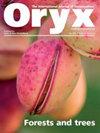Threats to the Critically Endangered yellow-headed tortoise Indotestudo elongata in Jalthal Forest, eastern lowland Nepal
IF 2.1
3区 环境科学与生态学
Q2 BIODIVERSITY CONSERVATION
引用次数: 0
Abstract
Jalthal Forest (62.6 km尼泊尔东部低地贾塔尔森林中极度濒危的黄头陆龟Indotestudo elongata面临的威胁
贾塔尔森林(62.6平方公里)是尼泊尔东部低地曾经连续、郁郁葱葱、茂密的萨尔·肖拉·罗布斯塔和混合落叶植被地区的残余森林,现在被密集的人口所包围。这片森林是濒临绝种的黄头龟(Indotestudo elongata)最后的适宜栖息地之一。本研究于2021年9月至11月期间,通过对20个社区森林的实地调查和对22个社区森林用户群体和当地居民的80名成员的结构化访谈,探讨了Jalthal森林黄头龟的分布和面临的保护威胁。在11.3 km2的调查范围内,只发现了4株,种群密度为0.35株/km2。当地人认为物种减少的主要原因是狩猎(42%)和入侵物种入侵导致的栖息地恶化(30%)。根据对参与狩猎的当地人的采访,2017-2021年期间,每年平均有6.8只陆龟被杀死。狩猎的目的是Meche和Sathar社区的消费(70%)和民族医药用途(30%)。为了在贾塔尔森林中保护这一物种,需要在所有利益相关者之间开展宣传活动和沟通网络。
本文章由计算机程序翻译,如有差异,请以英文原文为准。
求助全文
约1分钟内获得全文
求助全文
来源期刊

Oryx
环境科学-生态学
CiteScore
5.30
自引率
7.40%
发文量
150
审稿时长
18-36 weeks
期刊介绍:
ORYX—THE INTERNATIONAL JOURNAL OF CONSERVATION, a quarterly journal from Fauna & Flora International, publishes research on biodiversity conservation, conservation policy and sustainable use, and the interactions of these matters with social, economic and political issues. The journal has a particular interest in material with the potential to improve conservation management and practice. Explore the map for details of published articles.
 求助内容:
求助内容: 应助结果提醒方式:
应助结果提醒方式:


